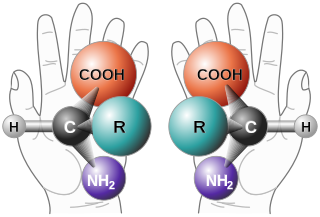
A photonic crystal is an optical nanostructure in which the refractive index changes periodically. This affects the propagation of light in the same way that the structure of natural crystals gives rise to X-ray diffraction and that the atomic lattices of semiconductors affect their conductivity of electrons. Photonic crystals occur in nature in the form of structural coloration and animal reflectors, and, as artificially produced, promise to be useful in a range of applications.

A metamaterial is any material engineered to have a property that is not found in naturally occurring materials. They are made from assemblies of multiple elements fashioned from composite materials such as metals and plastics. These materials are usually arranged in repeating patterns, at scales that are smaller than the wavelengths of the phenomena they influence. Metamaterials derive their properties not from the properties of the base materials, but from their newly designed structures. Their precise shape, geometry, size, orientation and arrangement gives them their smart properties capable of manipulating electromagnetic waves: by blocking, absorbing, enhancing, or bending waves, to achieve benefits that go beyond what is possible with conventional materials.
Nanophotonics or nano-optics is the study of the behavior of light on the nanometer scale, and of the interaction of nanometer-scale objects with light. It is a branch of optics, optical engineering, electrical engineering, and nanotechnology. It often involves dielectric structures such as nanoantennas, or metallic components, which can transport and focus light via surface plasmon polaritons.

Harry Albert Atwater, Jr. is an American physicist and materials scientist and is the Otis Booth Leadership Chair of the Division of Engineering and Applied Science at the California Institute of Technology. Currently he is the Howard Hughes Professor of Applied Physics and Materials Science and the Director for the Liquid Sunlight Alliance (LiSA), a Department of Energy Hub program for solar fuels. Atwater's scientific effort focuses on nanophotonic light-matter interactions and solar energy conversion. His current research in energy centers on high efficiency photovoltaics, carbon capture and removal, and photoelectrochemical processes for generation of solar fuels. His research has resulted in world records for solar photovoltaic conversion and photoelectrochemical water splitting. His work also spans fundamental nanophotonic phenomena, in plasmonics and 2D materials, and also applications including active metasurfaces and optical propulsion.

Nader Engheta is an Iranian-American scientist. He has made pioneering contributions to the fields of metamaterials, transformation optics, plasmonic optics, nanophotonics, graphene photonics, nano-materials, nanoscale optics, nano-antennas and miniaturized antennas, physics and reverse-engineering of polarization vision in nature, bio-inspired optical imaging, fractional paradigm in electrodynamics, and electromagnetics and microwaves.

Vladimir (Vlad) M. Shalaev is a Distinguished Professor of Electrical and Computer Engineering and Scientific Director for Nanophotonics at Birck Nanotechnology Center, Purdue University.
Satoshi Kawata is a scientist based in Japan who is active in nanotechnology, photonics, plasmonics, and other areas of applied physics. He is a Professor of Department of Applied Physics at Osaka University. He is also a Chief Scientist at RIKEN. Kawata is the president of Optica, 2022.
Michal Lipson is an American physicist known for her work on silicon photonics. Lipson was named a 2010 MacArthur Fellow for contributions to silicon photonics especially towards enabling GHz silicon active devices. Until 2014, she was the Given Foundation Professor of Engineering at Cornell University in the school of electrical and computer engineering and a member of the Kavli Institute for Nanoscience at Cornell. She is now the Eugene Higgins Professor of Electrical Engineering at Columbia University. In 2009 she co-founded the company PicoLuz, which develops and commercializes silicon nanophotonics technologies. In 2019, she co-founded Voyant Photonics, which develops next generation lidar technology based on silicon photonics. In 2020 Lipson was elected the 2021 Vice President of The Optical Society and will serve as OSA President in 2023.

A photonic metamaterial (PM), also known as an optical metamaterial, is a type of electromagnetic metamaterial, that interacts with light, covering terahertz (THz), infrared (IR) or visible wavelengths. The materials employ a periodic, cellular structure.

The term chiral describes an object, especially a molecule, which has or produces a non-superposable mirror image of itself. In chemistry, such a molecule is called an enantiomer or is said to exhibit chirality or enantiomerism. The term "chiral" comes from the Greek word for the human hand, which itself exhibits such non-superimposeability of the left hand precisely over the right. Due to the opposition of the fingers and thumbs, no matter how the two hands are oriented, it is impossible for both hands to exactly coincide. Helices, chiral characteristics (properties), chiral media, order, and symmetry all relate to the concept of left- and right-handedness.

Transformation optics is a branch of optics which applies metamaterials to produce spatial variations, derived from coordinate transformations, which can direct chosen bandwidths of electromagnetic radiation. This can allow for the construction of new composite artificial devices, which probably could not exist without metamaterials and coordinate transformation. Computing power that became available in the late 1990s enables prescribed quantitative values for the permittivity and permeability, the constitutive parameters, which produce localized spatial variations. The aggregate value of all the constitutive parameters produces an effective value, which yields the intended or desired results.
Quantum metamaterials extend the science of metamaterials to the quantum level. They can control electromagnetic radiation by applying the rules of quantum mechanics. In the broad sense, a quantum metamaterial is a metamaterial in which certain quantum properties of the medium must be taken into account and whose behaviour is thus described by both Maxwell's equations and the Schrödinger equation. Its behaviour reflects the existence of both EM waves and matter waves. The constituents can be at nanoscopic or microscopic scales, depending on the frequency range .
Ortwin Hess is a German-born theoretical physicist at Trinity College Dublin (Ireland) and Imperial College London (UK), working in condensed matter optics. Bridging condensed matter theory and quantum optics he specialises in quantum nanophotonics, plasmonics, metamaterials and semiconductor laser dynamics. Since the late 1980s he has been an author and coauthor of over 300 peer-reviewed articles, the most popular of which, called "'Trapped rainbow' storage of light in metamaterials", was cited more than 400 times. He pioneered active nanoplasmonics and metamaterials with quantum gain and in 2014 he introduced the "stopped-light lasing" principle as a novel route to cavity-free (nano-) lasing and localisation of amplified surface plasmon polaritons, giving him an h-index of 33.
Michael J. Sailor is a nanotechnology researcher and professor at the University of California, San Diego. Sailor is best known for his research on porous silicon, a nanostructured material that is prepared by electrochemical corrosion of crystalline silicon wafers.

Yuri S. Kivshar, Australian Scientist of Ukrainian origin, distinguished professor, head of Nonlinear Physics Centre of The Australian National University (ANU) and research director of The International Research Centre for Nanophotonics and Metamaterials, Australian Federation Fellow.

An electromagnetic metasurface refers to a kind of artificial sheet material with sub-wavelength thickness. Metasurfaces can be either structured or unstructured with subwavelength-scaled patterns in the horizontal dimensions.

Prof. Ravindra Kumar Sinha is the Vice Chancellor of Gautam Buddha University, Greater Noida, Gautam Budh Nagar Under UP Government. He was the director of the CSIR-Central Scientific Instruments Organisation (CSIR-CSIO) Sector-30C, Chandigarh-160 030, India. He has been a Professor - Applied Physics, Dean-Academic [UG] & Chief Coordinator: TIFAC-Center of Relevance and Excellence in Fiber Optics and Optical Communication, Mission REACH Program, Technology Vision-2020, Govt. of India Delhi Technological University Bawana Road, Delhi-110042, India.

Anatoly V. Zayats is a British experimental physicist of Ukrainian origin known for his work in nanophotonics, plasmonics, metamaterials and applied nanotechnology. He is currently a Chair in Experimental Physics and the head of the Photonics & Nanotechnology Group at King's College London. He is a co-director of the London Centre for Nanotechnology and the London Institute for Advanced Light Technologies
Shanhui Fan is a Chinese-born American electrical engineer and physicist, with a focus on theoretical, computational and numerical aspects of photonics and electromagnetism. He is a professor of electrical engineering, and a professor of applied physics at Stanford University. He is the director of the Edward L. Ginzton Lab and Senior Fellow at the Precourt Institute for Energy.
Mark Stockman was a Soviet-born American physicist. He was a Professor of Physics and Astronomy at Georgia State University. Best known for his contributions to plasmonics, Stockman has co-theorized plasmonic lasers, also known as spasers, in 2003.












